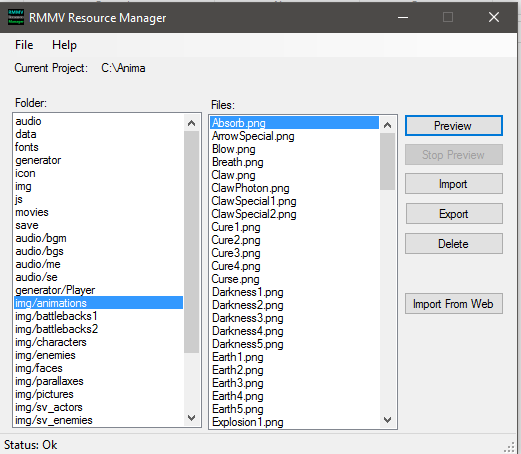

Maybe you simply need a few extras or adjustments to an existing tileset, in which case you may want to simply edit a tile sheet directly. The very first thing you should think about: What are you doing? Even if for the purpose of this tutorial I’ll be editing almost all the pieces for the tileset, that doesn’t have to be what you do. I’ll be making a sample map of a shop in a forest so we can illustrate the change from the default to the new edited tileset. What we will do is simple: create an edited tileset for a new area. I won’t be fiddling with the A tiles except for recoloring the basic grass, since autotiles require some knowledge and I’m not here to explain that. Configure the image to show a 32*32 pixel grid with a snap to grid function. Either edit an existing tilese sheet or create a new image of 512*512 pixels (for the B-E tiles, remember A tiles have different sizes).

Preparing the program: -Open the image editing program (I’ll be using Gimp). I will be using gimp because it’s the one I have and am used to, but any program that has a grid feature will do. Now, for this you will need an image editing program. Unlike the rest of the A tiles, these can be configured with 4 directional passability. The ceilings here can be used in any shape, unlike the A3 roofs. There is a specific setup to this sheet so be careful with it. A2 are the “ground+ground decoration” autotiles.

Quick A tiles reminder: -A1 are animated autoriles (usually water). The very first tile (upper left corner) in the B tile sheet is the “nothing” tile and must be empty and with a *star* passability. The B, C, D and E tile sheet are 512x512 pixels each, while the A tiles vary in size. If you’re unsure of how they work, try to simply replace the default tileset with what you want (water for water, walls for walls, grass for grass, etc). The A tiles have their own rules, which I won’t cover here. They can be configured from the Database. One tileset can hold the A1-5 tiles (the base tiles) and the B-E tiles (items, furniture, etc). A few things before we start:īasic Knowledge about tilesets: -Each tile is 32x32 pixels. This can mean changing the color of only one part of the tile or the entire thing (such as the bloom of a flower or the whole plant, leaves and all). Recoloring means changing the color of a tile. It’s usually done with plants (for wilderness natural effects) and small items. Clumping is to combine one or more tiles in a pattern so they create a cohesive and visually nice tiles. Rearranging is by far the easiest, it simply means moving the tile around in the grid so it has a different position (for example, moving furniture so they line up better with the walls). There are roughly 3 very simple techniques: rearranging, clumping and recoloring.

I will not talk about complex editing because frankly, I can’t do it myself so well, nor will I explain how image editors work in detail: there are many tutorials out there and help files to help you out, I will only give basic instructions. Now, what I will describe here is extremely basic. Simple edits can go a long way, and give the dreaded “RTP style” a fresh look if used well.
HOW TO IMPORT TILESETS IN RPG MAKER MV CRACK
So if you ever feel like those trees, caves and stones are looking boring, crack open a graphics editor and mess with the tiles a bit.” That said, I rarely see people posting screenshots of edited tilesets that are NOT parallaxes (those usually go hand in hand with editing so no need to mention them here), and there seems to be the fact that some people claim they could not “do that sort of thing”. The same grassy tiles can become a different map just by changing the colors (making the coloring greyer, more vibrant, a different tone, whatever) same goes for walls and floors. Small objects like flowers and single tile decorations are usually simple to cut and combine. It’s simple enough to recolor the flowers or make a simple cut/paste job to come up with new items. You may find that repeating, for example, the same weeds and flowers in fields over and over across the world gets old. Guide to simple tileset edits Once upon a time I submitted a mapping tutorial, and towards the end mentioned: “Simple edits and recolors: Everyone can do this, and it helps a lot to create ambience. This is my second tutorial and a bit more technical than the one I did before, so please bear with me if I have a harder time explaining myself.


 0 kommentar(er)
0 kommentar(er)
